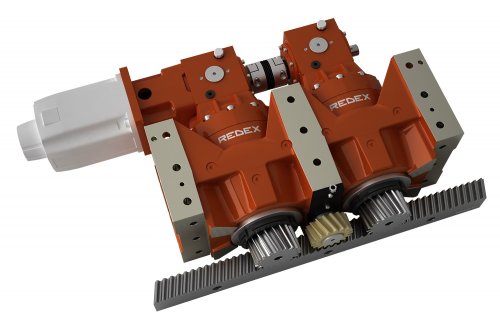
Redex USA showcased its portfolio of high-performance drives for machine tool applications at IMTS.
The Redex machine tool lineup features preloaded rack & pinion solutions for linear axis drives, ring gear and pinion for rotary axis drives, and 2-speed spindle drive gearboxes providing constant power to the spindle. Redex rack & pinion dedicated reducers are uniquely designed to provide high stiffness and work in combination with our DualDRIVE mechanical and TwinDRIVE electrical preloading technologies to eliminate backlash and ensure precise positioning over the entire axis length.
At Redex's booth were:
- Redex’ latest SRP+ and KRP+ Rack & Pinion Dedicated Reducers. These enhanced gearing solutions feature minimal transmission error for smooth operation and low noise while providing an excellent surface finish when driving machine tool axes. Thanks to continuous enhancements, SRP+ and KRP+ rack & pinion dedicated reducers offer seven to 40 percent greater torque capacity compared to previous versions.
- - Dual KRP Rack & Pinion Drive. This closed-loop system combines two KRP reducers and a DualDRIVE mechanical preload to eliminate backlash. Only one motor is required to drive the axis.
- -MSR High-Torque VTC Table Drive. Combining two identical right angle two-speed gearboxes that equally share the driving torque during turning, this turntable drive delivers precise, C-axis motion without backlash for milling and drilling operations.
Contact Details
Related Glossary Terms
- backlash
backlash
Reaction in dynamic motion systems where potential energy that was created while the object was in motion is released when the object stops. Release of this potential energy or inertia causes the device to quickly snap backward relative to the last direction of motion. Backlash can cause a system’s final resting position to be different from what was intended and from where the control system intended to stop the device.
- closed-loop system
closed-loop system
CNC system in which the program output, or the distance the slide moves, is measured and compared to the program input. The system automatically adjusts the output to be the same as the input.
- gang cutting ( milling)
gang cutting ( milling)
Machining with several cutters mounted on a single arbor, generally for simultaneous cutting.
- milling
milling
Machining operation in which metal or other material is removed by applying power to a rotating cutter. In vertical milling, the cutting tool is mounted vertically on the spindle. In horizontal milling, the cutting tool is mounted horizontally, either directly on the spindle or on an arbor. Horizontal milling is further broken down into conventional milling, where the cutter rotates opposite the direction of feed, or “up” into the workpiece; and climb milling, where the cutter rotates in the direction of feed, or “down” into the workpiece. Milling operations include plane or surface milling, endmilling, facemilling, angle milling, form milling and profiling.
- stiffness
stiffness
1. Ability of a material or part to resist elastic deflection. 2. The rate of stress with respect to strain; the greater the stress required to produce a given strain, the stiffer the material is said to be. See dynamic stiffness; static stiffness.
- turning
turning
Workpiece is held in a chuck, mounted on a face plate or secured between centers and rotated while a cutting tool, normally a single-point tool, is fed into it along its periphery or across its end or face. Takes the form of straight turning (cutting along the periphery of the workpiece); taper turning (creating a taper); step turning (turning different-size diameters on the same work); chamfering (beveling an edge or shoulder); facing (cutting on an end); turning threads (usually external but can be internal); roughing (high-volume metal removal); and finishing (final light cuts). Performed on lathes, turning centers, chucking machines, automatic screw machines and similar machines.






